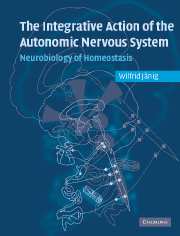Book contents
- Frontmatter
- Contents
- Foreword
- Preface
- List of abbreviations
- Introduction
- Part I The autonomic nervous system: functional anatomy and visceral afferents
- Part II Functional organization of the peripheral autonomic nervous system
- Chapter 3 The final autonomic pathway and its analysis
- Chapter 4 The peripheral sympathetic and parasympathetic pathways
- Chapter 5 The enteric nervous system
- Part III Transmission of signals in the peripheral autonomic nervous system
- Part IV Central representation of the autonomic nervous system in spinal cord, brain stem and hypothalamus
- References
- Index
Chapter 4 - The peripheral sympathetic and parasympathetic pathways
Published online by Cambridge University Press: 10 August 2009
- Frontmatter
- Contents
- Foreword
- Preface
- List of abbreviations
- Introduction
- Part I The autonomic nervous system: functional anatomy and visceral afferents
- Part II Functional organization of the peripheral autonomic nervous system
- Chapter 3 The final autonomic pathway and its analysis
- Chapter 4 The peripheral sympathetic and parasympathetic pathways
- Chapter 5 The enteric nervous system
- Part III Transmission of signals in the peripheral autonomic nervous system
- Part IV Central representation of the autonomic nervous system in spinal cord, brain stem and hypothalamus
- References
- Index
Summary
In this chapter I describe the reflex patterns for different groups of autonomic neurons, in particular sympathetic neurons. For other groups of autonomic neurons that have not yet been investigated in this way, I will draw indirect conclusions by analogy to those that have been investigated. Using this approach we gather information about the functional specificity of different neurons, about the relation between activity in certain types of neurons and the responses of the target tissue as well as information about the principal organization of the central circuits that determine the discharge pattern of these neurons (see Chapters 8 to 11). Thus, the experimental data described in this chapter are an important cornerstone of this book: they show that each autonomic pathway exhibits a characteristic pattern of discharge and that this is dependent on the structure of the central circuits in the neuraxis and the synaptic connections of these circuits with the different groups of afferent input to the neuraxis. This type of analysis gives the ultimate underpinning for the concept that the autonomic nervous system consists of functionally distinct building blocks (Jänig and McLachlan 1992a, b). As I have emphasized in Chapter 3, this description does not show how these autonomic systems function during ongoing regulation of autonomic function. This will be discussed in Chapters 5 to 10.
A similar approach has been used for the analysis of the somatomotor system.
- Type
- Chapter
- Information
- Integrative Action of the Autonomic Nervous SystemNeurobiology of Homeostasis, pp. 106 - 167Publisher: Cambridge University PressPrint publication year: 2006
- 6
- Cited by



